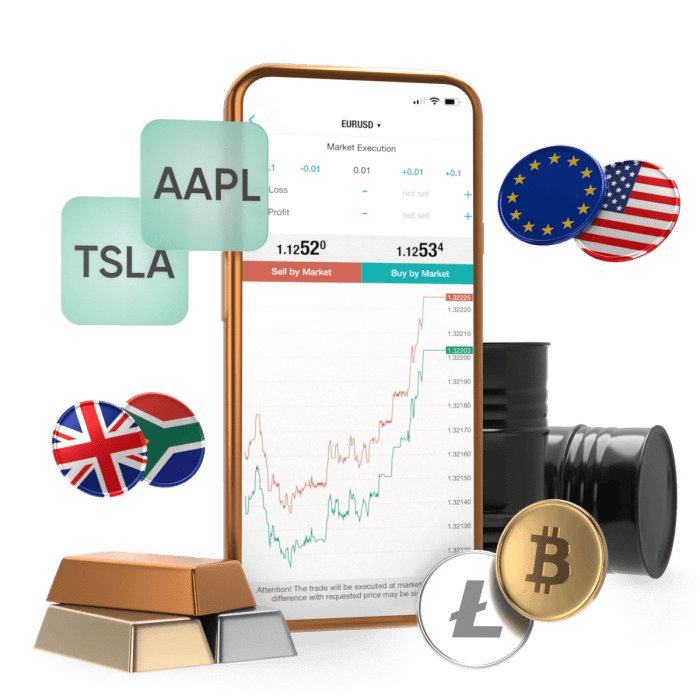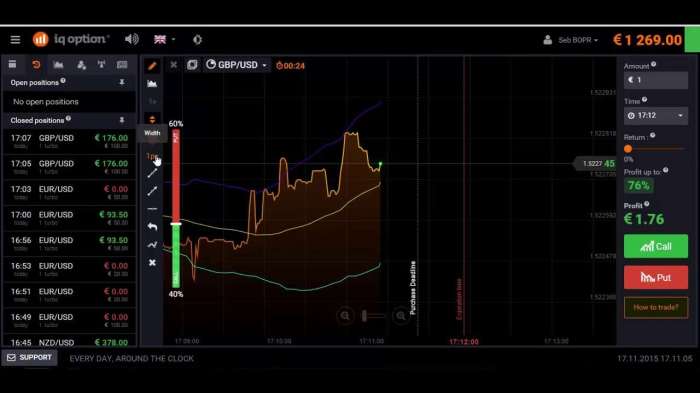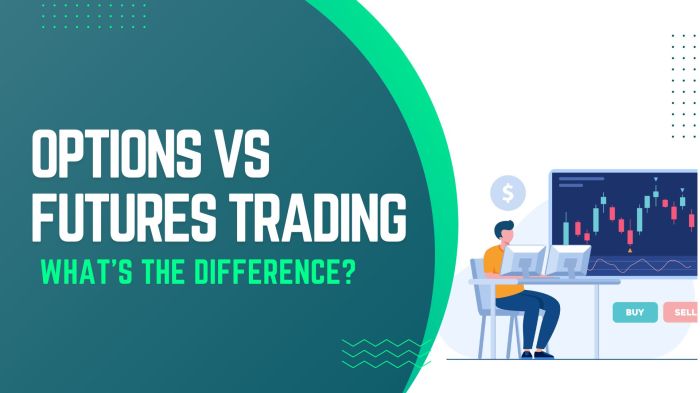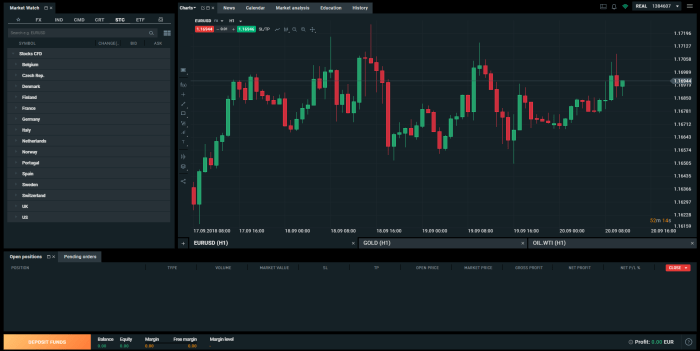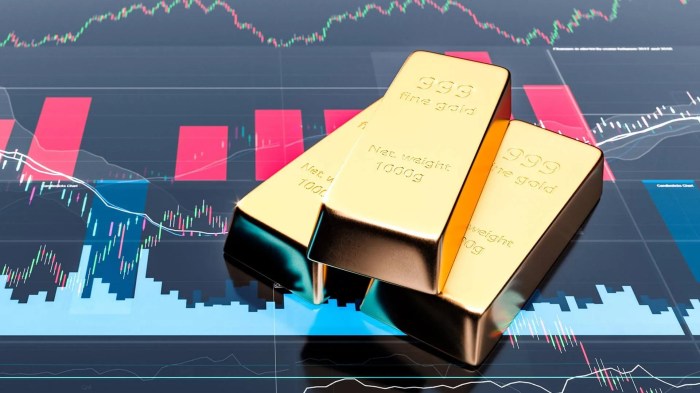
Gold trading forex: Dive into the glittering world of precious metal investment! This isn’t your grandpa’s gold rush; we’re talking about navigating the dynamic forex market, where gold’s value dances to the rhythm of global economics and geopolitics. We’ll unravel the mysteries of spot trading, futures, and options, equipping you with the knowledge to potentially strike it rich (responsibly, of course!). Prepare for a deep dive into technical indicators, risk management strategies, and the economic forces that shape gold’s price. Get ready to learn how to analyze market trends, predict price movements, and develop your own winning trading strategies.
From understanding the fundamental factors influencing gold prices—inflation, interest rates, and global events—to mastering technical analysis tools, this guide is your compass in the exciting, and sometimes volatile, world of gold trading within the forex market. We’ll explore various trading platforms, compare their features, and even walk through real-life examples of successful (and not-so-successful) gold trading scenarios. So, buckle up, and let’s turn your gold dreams into reality.
Introduction to Gold Trading in the Forex Market
Gold, a timeless symbol of wealth and stability, holds a unique position in the forex market. Unlike fiat currencies, its value isn’t tied to a single government’s monetary policy. This makes it an attractive asset for investors seeking diversification and a hedge against inflation or economic uncertainty. Trading gold within the forex market offers leveraged access to this precious metal, allowing traders to potentially profit from price fluctuations with relatively smaller capital investments.
Gold’s price in the forex market is influenced by a complex interplay of factors. These factors can be broadly categorized as macroeconomic conditions, geopolitical events, and market sentiment. Understanding these influences is crucial for successful gold trading.
Factors Influencing Gold Prices
Several key factors significantly impact gold’s price. Economic data releases, such as inflation reports and interest rate decisions from central banks, often trigger price movements. A rise in inflation, for instance, can drive investors towards gold as a safe haven, increasing its demand and price. Conversely, rising interest rates can make holding non-interest-bearing assets like gold less attractive, potentially lowering its price. Geopolitical instability, such as wars or political upheavals, also tends to boost gold’s appeal as investors seek refuge in its perceived safety. Market sentiment, driven by news reports, analyst opinions, and overall investor confidence, plays a significant role in shaping gold’s price trajectory. For example, negative news about the global economy might lead to increased demand for gold, driving its price upwards.
Historical Overview of Gold’s Performance
Gold’s performance in the forex market has been varied throughout history. While it has historically served as a safe haven during times of economic uncertainty, its price isn’t always directly correlated with other market indices. For instance, during periods of low inflation and strong economic growth, gold’s price might remain relatively stagnant or even decline. However, during periods of high inflation, economic crisis, or geopolitical turmoil, its value tends to appreciate significantly. Consider the 2008 financial crisis: as global markets plummeted, gold’s price surged, demonstrating its role as a safe-haven asset. More recently, the COVID-19 pandemic initially led to a sharp increase in gold prices as investors sought safety and stability. Understanding these historical trends is crucial for developing informed trading strategies. The long-term price movements demonstrate the impact of various macroeconomic and geopolitical factors on gold’s value over time.
Trading Mechanisms and Platforms
Diving into the world of gold trading within the forex market reveals a fascinating array of mechanisms and platforms. Understanding these nuances is crucial for navigating this dynamic market successfully. The choice of trading method and platform significantly impacts your trading experience, from the fees you pay to the tools available for analysis and execution.
Gold, a safe-haven asset, is traded predominantly through contracts rather than physical delivery. This makes it accessible to a broader range of investors. The most common methods are spot trading, futures contracts, and options contracts. Each offers a different level of risk and reward, catering to diverse trading strategies and risk tolerances.
Remember to click forex currency trading basics to understand more comprehensive aspects of the forex currency trading basics topic.
Spot Trading
Spot trading involves the immediate exchange of gold at the current market price. This is the most straightforward way to trade gold in the forex market. Transactions are typically settled within two business days. Spot trading offers flexibility and allows traders to capitalize on short-term price fluctuations. It’s ideal for those comfortable with the inherent risks of short-term price volatility.
Futures Contracts
Futures contracts are agreements to buy or sell a specific amount of gold at a predetermined price on a future date. These contracts are standardized and traded on exchanges, offering a degree of price certainty. Futures contracts are useful for hedging against price risks or speculating on future price movements. However, they carry significant risks due to leverage and the potential for large losses if the market moves against your position. For example, a trader might buy a gold futures contract anticipating a price increase, locking in a purchase price today for delivery in three months.
Options Contracts
Options contracts grant the buyer the right, but not the obligation, to buy or sell gold at a specific price (the strike price) on or before a certain date (the expiration date). This provides flexibility and risk management tools. Call options grant the right to buy, while put options grant the right to sell. Options trading is more complex than spot or futures trading and requires a deeper understanding of options pricing and risk management. A trader might buy a gold call option, betting on a price increase without the commitment of a futures contract. If the price doesn’t rise, they only lose the premium paid for the option.
Forex Trading Platforms for Gold
Numerous forex brokers offer gold trading through their platforms. These platforms vary significantly in their features, fees, and user interfaces. Choosing the right platform depends on your trading style, experience level, and specific needs.
Comparison of Forex Trading Platforms
| Platform | Spread (Typical) | Leverage | Commissions |
|---|---|---|---|
| MetaTrader 4 (MT4) | Variable, depends on broker | Varies by broker, can be high | Varies by broker, some charge per trade |
| MetaTrader 5 (MT5) | Variable, depends on broker | Varies by broker, can be high | Varies by broker, some charge per trade |
| cTrader | Generally tighter spreads than MT4/MT5 | Varies by broker, can be high | Varies by broker, some charge per trade |
Note: Spreads, leverage, and commissions are subject to change and vary significantly between brokers. Always check with your chosen broker for the most up-to-date information.
Obtain direct knowledge about the efficiency of simulated forex trading through case studies.
Market Analysis and Technical Indicators: Gold Trading Forex

Navigating the gold market successfully requires a blend of understanding the big picture (fundamental analysis) and deciphering price charts (technical analysis). Both are crucial tools, and using them in conjunction can significantly improve your trading decisions. Ignoring either approach significantly limits your potential for profit.
Fundamental analysis delves into the underlying economic and geopolitical factors that influence gold’s price. Technical analysis, on the other hand, focuses on historical price and volume data to identify patterns and predict future price movements.
Fundamental Analysis Techniques for Gold
Fundamental analysis for gold involves assessing factors that impact its value as a safe-haven asset and an industrial commodity. Key areas to consider include inflation rates, interest rates, the US dollar’s strength (gold is inversely correlated with the dollar), geopolitical instability, and central bank policies. For example, a period of high inflation often leads to increased demand for gold as investors seek to protect their purchasing power. Similarly, uncertainty in global markets due to political tensions typically boosts gold prices as investors flock to this safe haven. Analyzing economic reports like the Consumer Price Index (CPI) and the Producer Price Index (PPI) can offer valuable insights into inflationary pressures. Monitoring the Federal Reserve’s monetary policy decisions is also critical, as interest rate hikes can impact the attractiveness of holding gold relative to other assets.
Key Technical Indicators for Gold Price Prediction
Three key technical indicators frequently used in gold trading are the Moving Average Convergence Divergence (MACD), Relative Strength Index (RSI), and Bollinger Bands.
Moving Average Convergence Divergence (MACD)
The MACD is a momentum indicator that shows the relationship between two moving averages of a security’s price. It helps identify potential buy and sell signals based on the convergence and divergence of these averages. A bullish crossover occurs when the MACD line crosses above the signal line, suggesting a potential upward trend. Conversely, a bearish crossover occurs when the MACD line crosses below the signal line, suggesting a potential downward trend. For example, a bullish crossover in the gold MACD might signal a potential buying opportunity, while a bearish crossover could suggest a time to consider selling or hedging positions. The MACD’s sensitivity to price changes makes it a valuable tool for identifying short-term trading opportunities.
Relative Strength Index (RSI)
The RSI measures the magnitude of recent price changes to evaluate overbought or oversold conditions in the market. It ranges from 0 to 100. Readings above 70 generally indicate an overbought market, suggesting a potential price correction or pullback. Readings below 30 often signal an oversold market, suggesting a potential price rebound. For instance, an RSI reading of 80 for gold might suggest that the price is likely to fall, offering a potential short selling opportunity. Conversely, an RSI reading of 20 might signal a potential buying opportunity, as the price is likely to rebound. However, it’s important to note that the RSI can sometimes remain in overbought or oversold territory for extended periods, particularly in strong trends.
Bollinger Bands
Bollinger Bands consist of three lines: a simple moving average (SMA) and two standard deviation bands above and below the SMA. These bands visually represent the price volatility of an asset. When the price touches the upper band, it often suggests an overbought condition, and when it touches the lower band, it often suggests an oversold condition. Price breakouts above the upper band can be interpreted as strong bullish signals, while breakouts below the lower band can be viewed as strong bearish signals. For example, if gold’s price consistently trades above the upper Bollinger Band, it might suggest a strong uptrend, while consistently trading below the lower band might indicate a strong downtrend. The width of the bands also provides insights into volatility; wider bands suggest increased volatility, while narrower bands suggest decreased volatility.
Sample Trading Strategy Incorporating Fundamental and Technical Analysis
A successful gold trading strategy integrates both fundamental and technical analysis. For example, a trader might identify a fundamentally bullish scenario—e.g., rising inflation and geopolitical uncertainty—and then use technical indicators like the MACD and RSI to pinpoint optimal entry and exit points. If the fundamental outlook is bullish, the trader might wait for a bullish crossover in the MACD and an RSI reading below 30 (oversold condition) to initiate a long position. They might then set a stop-loss order below a key support level and a take-profit order at a predetermined price target or when the RSI reaches overbought levels (above 70). This approach combines the long-term perspective of fundamental analysis with the precision of technical analysis for improved risk management and profit potential. It’s important to remember that no strategy guarantees profits, and thorough risk management is essential.
Risk Management and Trading Strategies

Navigating the gold market, even with its perceived stability, requires a robust strategy and a keen awareness of risk. Gold’s price fluctuations, while often less volatile than other forex pairs, can still lead to significant losses if not managed properly. Understanding and implementing effective risk management techniques is crucial for long-term success. This section Artikels key risk management strategies and explores various trading approaches tailored to different risk appetites.
Risk Management Techniques in Gold Trading
Effective risk management in gold trading involves a multifaceted approach. It’s not just about limiting losses; it’s about preserving capital to participate in future opportunities. This includes careful position sizing, the strategic use of stop-loss orders, and a thorough understanding of your own risk tolerance. Position sizing determines the amount of capital allocated to each trade, minimizing the impact of a losing trade on your overall portfolio. Stop-loss orders automatically exit a position when the price reaches a predetermined level, limiting potential losses. For example, if you buy gold at $1900 per ounce, a stop-loss order at $1880 would automatically sell your position if the price drops to that level, limiting your loss to $20 per ounce. This is crucial in mitigating unforeseen market movements. Understanding your risk tolerance – your comfort level with potential losses – is paramount in determining appropriate position sizes and stop-loss levels. A conservative trader might risk only 1% of their capital per trade, while a more aggressive trader might risk 2% or more.
Trading Strategies for Gold
Choosing the right trading strategy depends heavily on your risk tolerance, time commitment, and trading goals. Here are three distinct strategies, each with its own set of advantages and disadvantages:
- Scalping: This high-frequency strategy aims to profit from small price movements within short timeframes (minutes or even seconds). Scalpers use technical indicators to identify short-term trends and execute numerous trades throughout the day.
- Advantages: Potential for quick profits, relatively low capital commitment per trade.
- Disadvantages: High stress levels, requires constant monitoring, susceptible to transaction costs.
- Swing Trading: This medium-term strategy involves holding positions for several days or weeks, capitalizing on price swings within a larger trend. Swing traders utilize chart patterns and technical indicators to identify potential entry and exit points.
- Advantages: Less time-intensive than scalping, potential for larger profits than scalping.
- Disadvantages: Higher risk due to longer holding periods, requires a good understanding of market trends.
- Long-Term Investing: This strategy involves holding gold positions for extended periods (months or years), aiming to benefit from long-term price appreciation. Long-term investors often focus on fundamental analysis and macroeconomic factors influencing gold prices.
- Advantages: Lower stress levels, potential for significant long-term gains, less susceptible to short-term market fluctuations.
- Disadvantages: Requires patience, opportunity cost of capital tied up for extended periods, less responsive to short-term market movements.
Economic Factors Affecting Gold Prices
Gold, often seen as a safe haven asset, doesn’t exist in a vacuum. Its price is a dynamic reflection of broader economic conditions, reacting to shifts in inflation, interest rates, and global political landscapes. Understanding these economic forces is crucial for any serious gold trader.
Inflation and Gold Prices
Inflation, the persistent increase in the general price level of goods and services, generally has a positive correlation with gold prices. When inflation rises, the purchasing power of fiat currencies decreases. Investors often see gold as a hedge against inflation, as its value tends to hold up or even increase during periods of rising prices. This is because gold is a tangible asset, unlike paper money, and its value is not directly tied to a specific government or economy. For example, during periods of high inflation in the 1970s, the price of gold soared dramatically. This historical precedent reinforces the perception of gold as an inflation hedge. The relationship isn’t always perfectly linear, however; other economic factors can influence the correlation.
Interest Rate Changes and Gold Prices
Interest rates, set by central banks, significantly influence the attractiveness of holding gold. Higher interest rates generally make holding non-interest-bearing assets like gold less appealing. This is because investors can earn a higher return on their investments in interest-bearing instruments like bonds or savings accounts. Conversely, lower interest rates can boost gold’s appeal, as the opportunity cost of holding gold decreases. The 2008 financial crisis provides a good example; as central banks slashed interest rates to near zero, investors flocked to gold, driving its price upwards.
Geopolitical Events and Gold Prices
Geopolitical uncertainty and instability frequently cause a surge in gold prices. Gold is considered a safe haven asset because it’s seen as a relatively stable store of value during times of political turmoil, economic crises, or international conflicts. Investors often move their money into gold as a protective measure when they perceive heightened risk in other asset classes. The Russian invasion of Ukraine in 2022, for instance, led to a significant increase in gold prices as investors sought refuge from the uncertainty. Similarly, periods of heightened trade tensions or political instability in major economies often result in increased gold demand.
Illustrative Examples of Gold Price Movements
Gold, a safe-haven asset, experiences price fluctuations driven by a complex interplay of economic, geopolitical, and market forces. Understanding these movements is crucial for successful gold trading. Let’s examine some key instances.
The 2020 Gold Price Surge
The year 2020 witnessed a significant surge in gold prices, reaching a record high above $2,000 per ounce. Several factors contributed to this dramatic increase. Firstly, the COVID-19 pandemic triggered widespread economic uncertainty and market volatility. Investors, seeking refuge from the turmoil, flocked to gold, driving up demand. Secondly, unprecedented monetary easing by central banks globally, including the US Federal Reserve’s massive quantitative easing program, significantly devalued fiat currencies, making gold, a non-yielding asset, relatively more attractive. Thirdly, geopolitical tensions, including escalating US-China trade disputes, further fueled investor demand for this safe-haven asset. The combination of these factors created a perfect storm, pushing gold prices to unprecedented levels. This demonstrates how macroeconomic events and policy decisions can significantly influence gold’s price trajectory.
Successful Gold Trading Strategy: Riding a Price Wave
Imagine a trader employing a momentum trading strategy in late 2022. Observing a consistent upward trend in gold prices, driven by rising inflation and a weakening dollar, they decide to enter a long position at $1,800 per ounce. Their analysis suggests further upward momentum, based on technical indicators like the Relative Strength Index (RSI) and moving averages. Over the next few weeks, gold steadily rises, reaching $1,850, then $1,900, and finally peaking at $1,950 before a slight correction. The trader, setting a take-profit order at $1,920, successfully exits their position, securing a profit of $120 per ounce. This illustrates how a well-timed entry and exit strategy, informed by technical analysis, can lead to profitable gold trades, even within relatively short-term price fluctuations.
Impact of Monetary Policy Change on Gold Prices
Let’s consider a hypothetical scenario. Suppose the Federal Reserve unexpectedly announces a hawkish shift in monetary policy, raising interest rates by 0.75% and signaling further increases. This would strengthen the US dollar, making dollar-denominated gold more expensive for international buyers. Simultaneously, higher interest rates would increase the opportunity cost of holding non-yielding assets like gold, potentially reducing investor demand. We could see a hypothetical price drop from $1,900 per ounce to $1,850 within a few trading sessions, reflecting the market’s reaction to the change in monetary policy. Conversely, a dovish policy shift, involving interest rate cuts, could lead to a price increase as investors seek alternatives to low-yielding bonds and other investments. This illustrates the sensitivity of gold prices to changes in central bank monetary policy, highlighting the importance of monitoring economic data and policy announcements.
Regulations and Legal Considerations

Navigating the world of gold trading in the forex market requires understanding the complex web of regulations and legal implications. Failure to comply can lead to significant financial penalties and legal repercussions. This section Artikels key regulatory bodies and best practices for ensuring legal compliance.
The regulatory landscape for gold trading varies significantly depending on your location. Understanding these differences is crucial for responsible trading. Different jurisdictions have different rules regarding the licensing and operation of forex brokers, as well as the reporting requirements for traders.
Regulatory Bodies Overseeing Gold Trading, Gold trading forex
International and national regulatory bodies play a vital role in overseeing gold trading activities. These bodies establish rules and regulations to protect investors and maintain market integrity. The specific regulatory bodies will vary based on the trader’s location and the broker’s jurisdiction. For example, in the United States, the Commodity Futures Trading Commission (CFTC) and the National Futures Association (NFA) are key regulatory bodies. In the UK, the Financial Conduct Authority (FCA) plays a similar role. Other countries have their own equivalent regulatory agencies. It’s crucial for traders to identify and understand the regulations enforced by the relevant authority in their region.
Legal Implications of Gold Trading in the Forex Market
Trading gold, like any financial instrument, carries legal implications. These implications include, but are not limited to, tax obligations on profits and losses, adherence to anti-money laundering (AML) regulations, and compliance with Know Your Customer (KYC) procedures. Failure to comply with AML and KYC regulations can result in severe penalties, including account suspension and legal action. Tax liabilities depend on individual circumstances and vary across jurisdictions. Accurate record-keeping is crucial for managing tax obligations effectively. Understanding the legal ramifications of trading before engaging in transactions is essential for responsible participation in the gold market.
Best Practices for Compliance with Regulations
Adhering to best practices is crucial for maintaining legal compliance in gold trading. This involves diligently researching and understanding the specific regulations in your jurisdiction. Thoroughly vetting your chosen forex broker to ensure it is properly licensed and regulated is also paramount. Maintaining meticulous records of all transactions, including dates, amounts, and counterparties, is vital for tax purposes and audits. Furthermore, understanding and complying with AML and KYC regulations, such as providing accurate identification documents, is non-negotiable. Regularly reviewing and updating your knowledge of relevant regulations is also a key component of maintaining compliance. Finally, seeking professional advice from a legal or financial expert can provide valuable insights and guidance.
End of Discussion
Mastering gold trading forex isn’t just about chasing profits; it’s about understanding the intricate dance between global economics, market sentiment, and technical analysis. This journey requires discipline, risk management, and a keen eye for detail. While we’ve covered the essentials—from fundamental analysis to identifying key technical indicators and crafting effective trading strategies—remember that consistent learning and adapting to market shifts are crucial for long-term success. So, equip yourself with knowledge, practice diligently, and remember that responsible trading is key to navigating this dynamic and rewarding market. The gold rush is on—are you ready?
